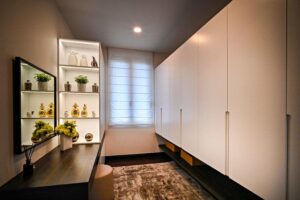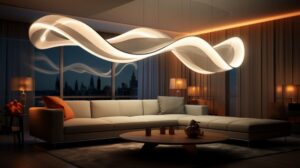Restaurants are not only about food; they are about the entire dining experience. Guests expect a meal that delights the senses, but equally, they look for an atmosphere that makes them feel welcome, comfortable, and inspired. This is where interior designers step in, crafting spaces that reflect identity, set a mood, and ensure diners return for more than just the menu. Ambience is created through careful decisions, and every detail contributes to the way people perceive a restaurant.
The Role of Interior Design in Dining Experiences
Interior design goes far beyond arranging furniture or adding stylish finishes. It shapes how people feel the moment they step inside. Ambience influences everything from appetite to conversation flow, and even the length of time guests spend at a table.
A well-designed restaurant engages the senses. The soft glow of lighting, the textures of seating, and the harmony between décor and layout work together to create a unique dining environment. Interior design also ensures practicality, enabling staff to work efficiently while guests remain comfortable. The right balance of creativity and functionality can make the difference between a space that merely looks good and one that feels unforgettable.
Key Elements That Shape Restaurant Ambience
Lighting
Lighting is one of the most powerful tools in creating atmosphere. Soft, warm tones invite intimacy, while brighter lighting works well in casual or family-friendly environments. Designers often layer lighting—combining ceiling fixtures, wall sconces, and table lampsto control mood at different times of the day.
Colour Schemes
Colours carry psychological weight. Warm shades can encourage appetite and conversation, while cooler tones may create calm and sophistication. A carefully chosen palette ensures a consistent mood throughout the space, aligning with the restaurant’s personality.
Furniture and Layout
The placement of tables, chairs, and booths affects flow and comfort. Guests should have enough privacy without feeling isolated, and staff need clear pathways for service. The choice of furniture also communicates style—whether it is contemporary minimalism, rustic charm, or classic luxury.
Textures and Materials
Wood, stone, fabric, and metal all carry their own character. Mixing textures brings depth, while high-quality materials communicate durability and class. Even subtle details, like the feel of a chair armrest or the look of polished flooring, influence perception.
Acoustics
Noise levels can make or break a dining experience. Designers use fabrics, wall panels, and ceiling treatments to absorb excess sound, creating an environment where conversation is effortless without the space feeling lifeless.

Design Strategies Used by Professionals
Interior designers employ a range of strategies to translate vision into ambience.
- Thematic Choices: Establishing a concept ensures coherence, whether it’s inspired by culture, history, or cuisine style.
- Zoning Spaces: Separating dining zones allows for varied experiences within one restaurant—for example, intimate corners for couples alongside communal areas for groups.
- Statement Décor: Artwork, centrepieces, or bold design features act as visual anchors, sparking curiosity and leaving a memorable impression.
- Smart Storage: Storage should be discreet but functional. Designers often adapt fitted wardrobes cardiff style solutions, integrating seamless storage without interrupting aesthetics.
These strategies ensure the ambience feels both intentional and natural, blending creativity with efficient use of space.
The Influence of Branding in Restaurant Interiors
Every restaurant has a story, and interiors bring that story to life. A brand’s values, identity, and tone should be visible not only in the menu but also in the physical setting.
From the choice of materials to the typography on signage, every element conveys meaning. Rustic wood might signal tradition and comfort, while sleek glass and steel speak to modernity. The consistency between branding and design reassures guests, building trust and recognition.
When branding is integrated into interiors, customers feel immersed in the restaurant’s world. They leave with a memory not only of the food but of the overall journey, making them more likely to return.

Modern Trends in Restaurant Interior Design
Sustainable Materials
Eco-conscious design is no longer a niche choice. From reclaimed wood to recycled fabrics, sustainable solutions demonstrate responsibility and attract environmentally aware guests.
Minimalist vs. Maximalist Approaches
Some restaurants lean into minimalist elegance—clean lines, neutral colours, and open spaces. Others embrace maximalism, using bold patterns, vivid colours, and rich décor to stimulate energy. Both trends have their place, depending on the desired atmosphere.
Multi-Functional Spaces
Flexibility has become crucial. Movable partitions, adaptable seating, and versatile lighting allow restaurants to adjust quickly for events, private functions, or changing needs.
Technology Integration
Modern diners expect efficiency. Designers now incorporate hidden wiring, smart lighting, and digital ordering systems, ensuring technology complements ambience without overpowering it.
Why Working with an Interior Designer Matters
Restaurants face immense competition, and ambience often becomes the deciding factor. Professional expertise ensures every aspect works together smoothly.
An interior designer Cardiff or similar professional brings a trained eye to details that non-specialists may overlook. They balance aesthetics with safety regulations, customer comfort, and operational flow. By analysing the target audience, they tailor interiors that appeal to the right demographic.
Hiring professionals also saves time and resources in the long run. Poor design choices can lead to costly renovations, while thoughtful planning prevents errors. The collaboration between clients and designers results in unique spaces that reflect individuality yet remain practical.
Conclusion
Restaurant ambience is never accidental; it is the result of deliberate choices guided by expertise. From lighting and colour schemes to furniture, branding, and sustainability, each decision shapes the customer experience. Professional designers provide the skills and insight to turn concepts into cohesive spaces that make lasting impressions. Just as fitted wardrobes cardiff solutions demonstrate the balance between style and functionality in homes, restaurant interiors rely on smart planning to achieve harmony.
For those aiming to create dining environments that captivate, working with specialists is the key. AO Builders Cardiff supports such projects with precision and professionalism, ensuring every detail contributes to an ambience that keeps guests coming back.



